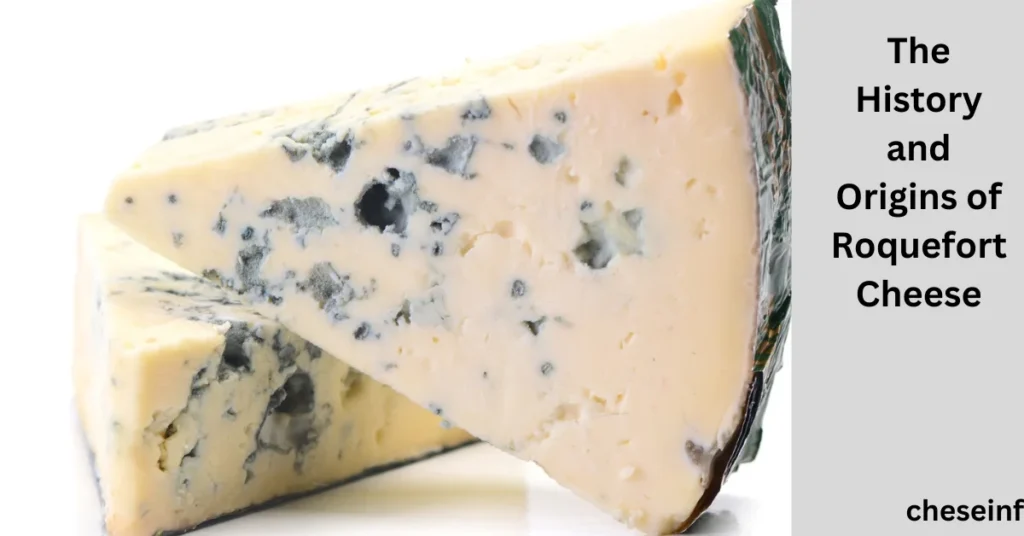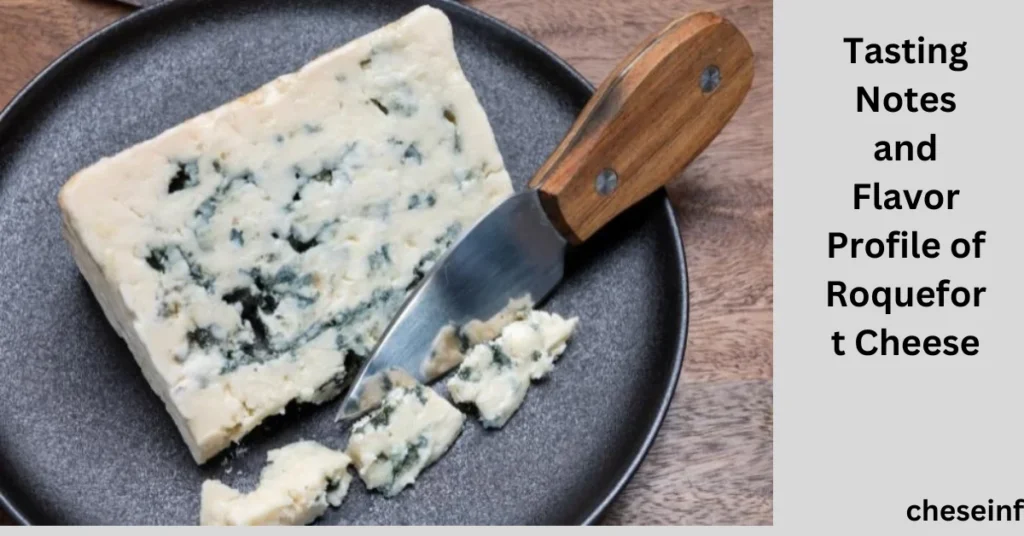As you walk down the cheese aisle, you stop, mesmerized by a striking blue-green wheel. This is Roquefort Cheese- a fascinating cheese that makes you curious about its tangy taste. What’s the story behind this intriguing cheese? Let’s find out together.
In this article, we’ll explore how Roquefort is made, experience its unique flavors, and learn tasty ways to enjoy this iconic French cheese. With its crumbly texture and strong aroma, Roquefort stands out from the rest. Whether you’re a cheese expert or just curious, you’ll gain a new appreciation for this complex cheese. So grab a wedge and join us as we delve into the legends, history, and flavors of delicious Roquefort cheese!
What Is Roquefort Cheese?
Roquefort is a blue veined cheese made from sheep’s milk in the Roquefort-sur-Soulzon region of France. It has a slightly crumbly yet creamy texture and a tangy, pungent flavor from the mold used to make it.
Aged to Perfection
Roquefort cheese is aged in the Combalou caves of Roquefort-sur-Soulzon for at least five months. The caves offer the perfect environment for the growth of Penicillium roqueforti, the same mold that gives Gorgonzola and Stilton their distinctive veiny appearance and sharp taste.
As the cheese ages, the mold creates air pockets and blue-green veins throughout the cheese. This is what gives Roquefort its characteristic marbling and pungent, spicy flavor. The longer it ages, the more intense the flavor becomes.
Made From Sheep’s Milk
Roquefort is made entirely from the milk of Lacaune sheep. The sheep graze on wild grasses and herbs, which gives their rich milk a distinct grassy, herbaceous quality that comes through in the finished cheese. The milk is cultured, coagulated, shaped into rounds, and then aged in the caves.
A Protected Designation of Origin
True Roquefort cheese can only be made in a specific region of Aveyron, France and must be aged in the Combalou caves. Any blue cheese not aged in these caves cannot be called Roquefort. This strict standard is enforced through France’s protected designation of origin (PDO) certification.
So next time you’re browsing the fromage selection, look for a wedge of authentic Roquefort cheese. With its crumbly yet creamy texture, blue-green veins, and robust, tangy flavor, Roquefort is a unique cheese that deserves a taste. Bon appetit!
The History and Origins of Roquefort Cheese

Roquefort cheese has been around for centuries. Legend has it that a young shepherd left his lunch of rye bread and sheep’s milk curd in a cave near Roquefort-sur-Soulzon in the south of France. When he returned months later, he found the curds had developed blue-green veins—and behold, the first Roquefort cheese was born!
Early Beginnings
In 1070, the village of Roquefort was already renowned for its blue cheese. King Charles VI granted the village a monopoly for the ripening of Roquefort cheese in 1411. This helped establish Roquefort as a prestigious cheese and guaranteed its quality and origin.
A Delicate Process
Roquefort cheese is made from sheep’s milk and aged in the natural caves of Roquefort-sur-Soulzon. The caves provide the ideal conditions for the growth of Penicillium roqueforti, a mold that gives Roquefort its distinctive veining and pungent taste. The mold is carefully cultivated and added to the curds, which are then aged for a minimum of three months.
A Protected Designation of Origin
Today, only cheese that is aged in the caves of Roquefort and made according to strict standards can bear the name Roquefort. It was one of the first cheeses in France to be awarded AOC status, meaning it meets the highest standards of excellence and authenticity. The AOC designation protects the tradition and quality of this historic blue cheese.
With a history spanning over a thousand years, Roquefort stands out as a cheese unlike any other. Its distinctive flavor and ripening process in the caves of Roquefort-sur-Soulzon make it a true French delicacy and cultural icon. If you haven’t tried it yet, you’re in for a treat—a pungent, crumbly treat with tons of character!
How Roquefort Cheese Is Made
Roquefort cheese has been made in the same way for centuries using only three simple ingredients: sheep’s milk, salt, and the Penicillium roqueforti mold. To make Roquefort, shepherds first collect sheep’s milk, then mix it with rennet to curdle it into curds.
Curdling and Molding
The curds are then molded and aged in the famous caves of Roquefort-sur-Soulzon. The caves provide the perfect environment, with cool, damp air and lots of natural air circulation. After a few days of aging in the caves, veins of blue-green mold start to appear within the curds.
Piercing and Salting
Once the mold has developed, workers pierce the curds with needles to allow oxygen in, which helps the mold grow further. The curds are then salted, which stops the growth of the mold. The salt also acts as a natural preservative and enhances the flavor of the cheese.
Further Aging
The pierced and salted curds continue to age for at least three months up to a year. As they age, the curds develop a soft, crumbly texture and pungent, tangy flavor from the Penicillium roqueforti mold and bacterial activity. The longer the cheese ages, the more intense the flavor becomes. Many people consider cheese aged six months to a year to have the most desirable flavor.
Ready to Enjoy
After the aging process is complete, the finished Roquefort cheese is ready to enjoy. Its soft, crumbly texture is perfect for spreading on bread, and its potent aroma and flavor is ideal for a cheese board. Roquefort’s distinctive tangy, savory taste comes from the same type of mold used to make bleu cheese, making it a delicious alternative for bleu cheese fans. Thanks to careful production methods passed down through generations, Roquefort maintains an unparalleled taste and quality that has made it world famous.
Tasting Notes and Flavor Profile of Roquefort Cheese

The flavor of Roquefort cheese is quite complex with many layers of tastes that unfold as you savor each bite. At first, you’ll notice a sharp, tangy kick from the penicillium roqueforti mold used to age the cheese. This gives Roquefort its distinctive veined blue appearance and pungent aroma.
A Sharp Yet Creamy Contradiction
Although quite pungent, Roquefort manages to also taste rich, buttery, and creamy. This seeming contradiction is part of what makes the flavor profile so interesting. The creamy texture comes from the high-fat sheep’s milk used to make the cheese. Subtle nutty, fruity flavors mingle with the sharpness, creating an overall balance.
Hints of Grass and Nuts
Notes of grass or fresh-cut hay are often detected in Roquefort, imparted from the diet of the Lacaune sheep. Almond or walnut flavors frequently emerge as well, especially when paired with a glass of Sauternes or other sweet wine.
An Endless Range of Pairings
The myriad of flavors in Roquefort means it pairs beautifully with many accompaniments. Spread it on bread with a drizzle of honey, or serve it alongside sliced pears. Roquefort also pairs classically with Sauternes or Port, whose sweetness contrasts the saltiness of the cheese. For a savory pairing, try Roquefort melted over grilled steak or used to stuff chicken breasts before baking.
Roquefort’s complex set of aromas and tastes provide an endless range of exploration for any cheese lover. Whether sampling it on its own, paired with wine or fruit, or incorporated into a dish, Roquefort’s flavor profile offers a sharp yet creamy taste of the French countryside. Let your palate get lost in the layers of grassy, nutty, tangy, and rich flavors that make this blue cheese a true delicacy.
How to Serve and Pair Roquefort Cheese
Roquefort cheese has a very distinctive flavor, so serving it thoughtfully is key. Here are some tips for serving Roquefort cheese and pairing it with complementary foods and drinks.
On a cheese board
Roquefort cheese is ideal for any cheese board. Place a wedge of Roquefort cheese in the center of the board surrounded by complementary cheeses like aged Gouda, Camembert, or Gruyere. Provide a knife for spreading the soft blue cheese onto bread, crackers or crusty baguette slices. Accompany with fresh or dried fruits like pears, apples, figs or apricots which pair nicely with the saltiness of the blue cheese.
In a salad
Crumble Roquefort cheese over a simple green salad for a pop of flavor. The pungent cheese pairs well with bitter greens like arugula. Add sweet elements like pears or pecans which contrast nicely with the sharpness of the blue cheese. A light vinaigrette allows the flavor of the cheese to shine through.
With wine or port
A glass of medium-bodied red wine like a Pinot Noir or Syrah is a classic pairing for Roquefort cheese. The fruitiness of the wine complements the tangy cheese. For a sweeter pairing, try a port wine. The richness of the port balances the saltiness of the blue cheese.
On a burger
Top a grilled beef burger patty with crumbled Roquefort cheese for a gourmet burger. The strong flavor of the cheese stands up well to a hearty beef patty. Caramelized onions or mushrooms make a great accompaniment. Serve the burger on a toasted bun with your favorite burger toppings like lettuce, tomato and bacon.
Roquefort cheese deserves to be appreciated on its own, but when paired thoughtfully with complementary flavors and textures, this pungent blue cheese becomes an even more decadent treat. Serve your Roquefort cheese with good company and a glass of bold red wine for a simple but elegant dining experience.
Conclusion
So there you have it – the full lowdown on Roquefort cheese. From its origins in the caves of Roquefort-sur-Soulzon to its funky blue veins and pungent flavor, this historic cheese stands out in the crowded world of fromage. Armed with a little background knowledge, you can now appreciate Roquefort for its complex taste profile and unique terroir.
Whether you’re sampling it straight, adding crumbles to salad, or using it to add oomph to a sauce, Roquefort is a delicious way to expand your cheese horizons. The next time you spot this iconic blue cheese at the market or on a menu, grab a wedge. Your taste buds will thank you for discovering the rich, nuanced pleasures of Roquefort.

where we’re dedicated to all things cheese! From easy DIY recipes to exploring different cheese types, we’re here to inspire and empower cheese lovers worldwide. Join us as we celebrate the joy of cheese-making and discovery
